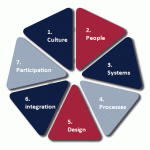Rolling Forecast can become the path leading to better company’s profitability and improved operating performance. This...
 Heinrich doesn’t have time for non-value-adding activities. An engineer with an MBA, he’s the general manager of a factory that makes packaging for the food industry. His five customers are exacting to say the least. The product quality must always be perfect, with the right quantity delivered to the right place at the right time with the right paperwork. It’s not surprising that Heinrich’s favourite maxim is “you can’t manage it if you don’t measure it.”
Heinrich doesn’t have time for non-value-adding activities. An engineer with an MBA, he’s the general manager of a factory that makes packaging for the food industry. His five customers are exacting to say the least. The product quality must always be perfect, with the right quantity delivered to the right place at the right time with the right paperwork. It’s not surprising that Heinrich’s favourite maxim is “you can’t manage it if you don’t measure it.”
Two years ago, the group moved away from our annual budget and monthly variance reports, and adopted quarterly rolling forecasts supported by key performance indicators and scorecards. Recently I asked Heinrich which approach was more useful to him as a line manager. Immediately he replied “of course rolling forecasts are far more valuable than budgets”.
He said the most important difference is embedded in the psychology behind rolling forecasts. “The budget was always a grudge purchase: I was preparing a set of numbers to keep my boss happy, and to give you FP&A guys something to report against. At the end of the day they were your numbers not my numbers. I knew they’d be out of date within a month or two when we gained or lost a big order or began working a second shift. With the rolling forecast they are my numbers. They reflect my current reality”.
“To prepare my budget I’d pull out last year’s file and update the spreadsheet as best I could, then send it off and forget about it for another year. Now I start by forecasting my key drivers for next quarter: a number of shifts, planned overtime, maintenance, wandering bottlenecks. My numbers are not based on any history, and entirely forward-looking”.
“And even though it wasn’t written down, there was always this mentality that you can’t spend the money if it’s not in the budget. My customers are all highly competitive FMCG companies who keep coming up with new ideas for their packaging. I have to be responsive to their needs. In the past I was judged each year in my performance appraisal on whether I achieved the budget or not, regardless of emergency orders, strikes, machine breakdowns or even hurricanes! I now have a process where I can forecast the necessary expenditure and have it authorised, and know it won’t bounce back on me in my appraisal. I can now spend money to make money”.
“The new system of reporting is a huge improvement. In the budget system, the actual performance was reported against budget each month in financial language, never in real-life language like hours or units or tons or recoveries. The variances mostly arose from price, volume and mix factors, which are impossible to predict for a year ahead and often beyond my control. The new system gives me real-time alerts on my dashboards and weekly summaries of my key performance indicators in each section of the factory. It’s miles better!”
| Annual budgets | Rolling forecasts | |
| Timing | Annual | Monthly or quarterly |
| Focus | Cost control | Value creation |
| Link to strategy | Tenuous | Direct |
| Mentality | Beat the budget | Information for decisions |
| Understanding reports | Financial language | Real-life language |
| Report variances | Not too useful | Very useful |
| Responsibility | Finance manager | Line managers |
| Basis of preparation | Last year’s numbers | Forecast business drivers |
| Focus of control | Centralised | Decentralised |
The article was first published in Unit 4 Prevero Blog
Subscribe to
FP&A Trends Digest

We will regularly update you on the latest trends and developments in FP&A. Take the opportunity to have articles written by finance thought leaders delivered directly to your inbox; watch compelling webinars; connect with like-minded professionals; and become a part of our global community.




